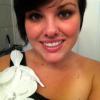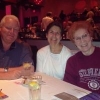Search the Community
Showing results for 'Yogurt'.
Found 17,501 results
-


8 months post Lap Band surgery & not enough restriction!!
topazz replied to fiona14's topic in POST-Operation Weight Loss Surgery Q&A
I am about 9 months out and am just finally starting to feel the band work. Up till now it has been nostly will power, and not much band. But for the first time, I am starting to feel fuller longer. I can now go about 3 hours solid without feeling hungry. When I felt hungry, I would eat a healthy snack like a Protein bar, yogurt or cheese stick. But i have noticed the past few days that I am not as hungry now. I know the key is to eat protein, but it gets tricky sometimes. But I am constantly reminding myself to decided it I am stomach hungry or head hungry before I reach for sometihng to eat. I also drink a lot of Water to give myself a temporary fullness to stretch it out for the next meal. I actually have another appointment on Wednesday, so I wonder if the PA will give me another fill. -
Hello. I've been banded for almost 4 years and have lost 95 pounds, give or take a few. I had a fill in January and was very restricted for about 2 weeks. Since then, the band has worked like I had hoped. I would eat a little and be full. I had to be careful, small bites, chew, chew, chew. However, for about a month, I drink my usual 12 oz protein shake in the morning and coffee, yogurt for lunch, 48 oz. of water throughout the day and then eat and drink whatever I'm hungry for, for dinner. The problem is that the evening eating is getting more and more. It seems like I can eat a lot some times and then other times things just get stuck. I think getting enough water has a lot to do with it but I'm scheduled to see my doctor in a couple of weeks and I'm not sure if I need a fill or not. I don't weigh myself a lot but I think I've lost about 5 pounds since January. I'd like to lose another 15. Any suggestions???? Thanks
-
Hi Janie, I hope the pain is improving. I have been really lucky and really have have had only mild discomfort and no gas pain. I am struggling to eat and drink but then my regime seems much faster than all yours. I started on Weetabix and yogurt which I can't cope with now. At least the fluids are going much better today and I have abandoned foods so far today. We are also looking at recipes, it is so good to hear new ideas, so please do share them when you are ready. Take care and hope the pain eases Claire
-
Hi Erin I tend to have eggs for breakfast - a favorite of mine before WLS - I find my day gets off to a god start with some protein and veggies. I usually have them scrambled or poached with a couple of slices of low-carb toast or add veggies & 1 oz low-fat cheese instead (mushrooms, peppers, tomatoes, green onions etc). Here's some other ideas I got from various WLS sites - hope they help - good luck. Egg Salad 2 boiled eggs, 1 tablespoon reduced-fat mayo, 3 Ryvita crisp-bread. Total calories = 364 Strawberry Nut Oatmeal Cook ¾ c dry old-fashioned quick oats with water (to desired consistency), and top with 1 c strawberries or blueberries and 2 Tbsp pecans. Total Calories = 375 Vanilla Fruit-and-Nut Parfait Mix 1½ c whole grain puffed cereal with 6 oz fat-free vanilla yogurt, 1 c blueberries, and 2 Tbsp almonds. Total Calories = 354 Southwest Breakfast Tacos Fill three soft corn tortillas with the following ingredients: ½ cup egg whites, scrambled; ¼ cup sliced Hass avocado ¼ cup low-fat shredded Cheddar cheese, and ¼ cup salsa verde. Total calories: 363 Breakfast Pita Warm 1 multigrain pita and fill evenly with 4 scrambled egg whites or ½ c liquid egg, ½ c fresh baby spinach leaves, ¼ c salsa, and ¼ c sliced avocado. Total Calories = 329 Toast and Cheese Toast 2 slices sesame-sprouted whole grain bread and top with ¼ c nonfat ricotta cheese and 2 Tbsp walnuts. Serve with 1 medium apple. Total Calories = 372 Cashew Crunch Top 1 slice sesame-sprouted whole grain bread with 2 Tbsp cashew butter and ¼ c raisins. Total Calories = 400 Mediterranean Breakfast Wrap Fill a 100% whole wheat wrap with ½ cup egg substitute, scrambled; 1 oz feta cheese; 1 diced plum tomato; and 10 large sliced black olives. Total calories: 364 Farm Fresh Egg & Cheese Sandwich Drizzle one toasted whole wheat English muffin with 1 Tbsp olive oil. Top the muffin with one large poached egg, 1 slice reduced-fat Swiss cheese, and half of a medium vine-ripened tomato, sliced. Total calories: 387 PB&A Oatmeal 2 Tbsp peanut butter, swirled into ¾ cup quick oatmeal, cooked, and topped with 1 medium sliced apple. Total Calories = 388
-
I don't have anything of note to report. That's good news because it means I'm finding some balance. To be honest I spent a lot of the last few weeks in misery. Between head hunger, frustration. Food habits and not being able to eat much of anything, I truly felt overwhelmed and a little defeated. It's been clicking in my head, though. Eat slowly. Small bites. Tiny, tiny portions. The lessons are being learned and I am doing ok! At work I drink my flavored water and eat mostly luquidy type stuff like yogurt and soup. It saves me any embarrassment from not tolerating a food or eating too fast and getting sick. At home I try to have some variation of what I've cooked for my family. I have a few staples on hand that I enjoy in case that isn't a possibility. I don't do the protein shakes. I just hate them. I'm down almost 18 pounds. I'm not going to complain. I thought it would be more but I think it's still more progress than I would've made without this surgery. Some of my favorites are avocado (nnegrates fault), laughing cow cheese, a small egg cooked with a bit of cream cheese to add fluffiness, and Cambell's chicken noodle soup. I've been enjoying yogurt as well. I just take a different one every day. Today I tried a string cheese on my way home from work. I think it will be ok but I need to eat it sloooowwly. How are you guys?
-
Hey Guys! I have 1 and 1/2 days left! I must say the liquid diet thing (I'm winging it too... diet shakes, Jello, non-chunky Soup, yogurt etc) has helped with my confidience.... I've lost 6 pounds... and in a way it makes me feel that I won't die with out "real" food. I listened to my friend and decied to grab a bit of my favorite foods (ok A LOT) and "pig out" before surgery, since I will never be able to again. You know what guys, I felt AWFUL!!!! Not just emotionally, guilty that I cheated. But I was nauseous, my stomach felt unsettled and heavy. It was probably the best idea ever cause now I KNOW I can do this! I hope this help ya'll fighting that liquid diet! :biggrin: Ambo Hey how can I get those weight/bmi counter dower things on my posts?
-


What do YOU eat in a typical day?
MINI-Me replied to JillianMarie's topic in POST-Operation Weight Loss Surgery Q&A
I am 5.5 months out. Here is a typical day for me: Breakfast - 6oz of Carbmaster yogurt with 1/2 scoop of Any whey Protein powder Snack - 1 or 2 string cheese lunch - 2.5 to 3 oz protein with Del Monte No Sugar Added Peaches Snack - 1/2 Protein Bar or 1 oz Jerky dinner - 2.5 to 3 oz protein with either a few bites of veggies or mashed potatoes Snack (not every night) - 10 mini pretzels or Russel Stover SF peanut brittle I may add a small glass of wine instead of a snack depending on protein intake for the day. -


where do you fit your protein in? how do you get calories?
Adri replied to MeMeMEEE's topic in Food and Nutrition
AVOCADO! It is high in calories and healthy fats. Poach chicken breasts and shred them, smother them with avocado and it helps the chicken go down easy. At 5 weeks out I could also add a little cheddar cheese and taco sauce. It was delicious to me cuz I was tired of all the artificial sweet stuff...shakes, Jello, yogurt, pudding...blaaaa! (poached salmon will really up the protein) -
My fill nurse told me to go to the cafe in the hospital after my fill and eat some yogurt. He said the yogurt should go down easy without feeling it come up or without a struggle. Even if you have some swelling it you should be able to get some thick liquid down. Call your doctor.
-


What do YOU eat in a typical day?
JillianMarie replied to JillianMarie's topic in POST-Operation Weight Loss Surgery Q&A
It's been almost 2 months, I have been very confused as far as post op directions because my surgeon gave me the clear to eat solids at 5 weeks, and was very strict at first with his post-op directions, but it seemed to progress very quickly. There aren't any local nutritionists that have experience with the sleeve, i have checked into it. I have even checked with the local weight loss surgery centers, and they only perform gastric bypass and lap-band, they have yet to perform the sleeve. I went to two different gastroenterologists seeking their opinions and looking for post- surgery follow up care, and they didn't really understand what I was there for. They said i was fine, and that I should be okay to eat what I am comfortable with eating, and that my stomach will let me know if i have trouble with any foods. One doctor told me to take new foods slow and cautiously, but at 5 weeks to introduce them in small amounts and that I should be okay with them and that the major healing has probably already occurred and my risk for leaks would be very low by that point. At this point the only foods that i have problems with are green Beans, and acidic foods or high fat foods (with the exception of Peanut Butter, it seems to be the only high fat food that agrees well with me AND keeps me full for most of the day). At times I wish i had used a different surgeon whom I would have follow up care with and had better outlines of everything from the start. I have been told different things by everyone. I can always go back to my "safe foods"- yogurt, smoothies, applesauce, and Protein shakes, and try to pass a few more weeks or a month by to give more healing time, as long as I keep myself busy I can distract myself from thinking about eating other foods. I seem to have a fairly high metabolism, after surgery i consumed quite a bit more than most people in the way of calories (around 900 a day through protein shakes) and still lost pretty fast. If I can aim at about 1200-1400 a day, I can slowly get to my goal, then maintain at around 1800-2000/day. -


What do YOU eat in a typical day?
texaschick replied to JillianMarie's topic in POST-Operation Weight Loss Surgery Q&A
Jillian, I am right there with you. I am not as far out as you, I am 5 weeks, but I feel I can eat way more than most people are posting. food seems to go down a lot easier than most people talk about. I am on vacation, and yesterday I ate the following with no issue: B: 1/2 vanilla yogurt with sprinkle of granola, two 1 inch Water melon cubes, 1 serving spoonful of scrabled eggs L: 3 large shrimp, 1 bite mac& cheese (had to try it!) S: 2oz grilled chix; small triange of chees and 2 crackers; 1 half dollar size crocquette D: 2 1/2 inch crab cake few edamame 1 steamed dumpling (again, I had to try it: Emeril's Tchoup chop restaurant) I can eat a whole small Wendy's chili without too much problem, but I am super full afterwards. I can eat an entire slightly larger than palm sized chix breast (I have found that it definitely needs to be super moist though) 2 eggs poached or over easy, but not much else with them, I haven't tried beef yet and I haven't done any raw veggies yet. I am dissapointed somewhat, but actually kind of happy that I was able to eat semi-normal on vacation, and be part of the "group". I didn't feel left out or angry that they could eat things I couldn't. When they ordered the banana creme pie at Emeril's it didn't even bug me. I didn't want any. Same with the gelato sundaes every night (although I did have a small scoop of mango sorbet one night when I didn't have much for dinner. And I did have a scoop of hazelnut gelato once and very shortly after experienced my first bought of "dumping". Sweaty, nauseous, no throwing up, but close). I plan on doing the 5 day pouch test when I get back to kind of de-carb myself, but I am finding a few carbs more carbs make all the difference in my attitude. Helps with the constipation, and general overall mood. -


Buyer's Remorse- My Horrible Road To "recovery" Post Sleevectomy
jsd2 posted a topic in Gastric Sleeve Surgery Forums
I'm so grateful to have found this site and have read a number of stories that made me feel less alone in my own struggle. Here is my story: March of 2008 I saw a weight loss surgeon who said all the right things to convince me I was too fat to lose weight on my own and the only way to have lifelong success was to sign up for WLS which required a thousand dollar deposit. I weighed 265 lbs at the time and in my late 30s was far too tired to try another diet and exercise program that would inevitably result in another 10lb weight gain. January of 2008 my employer switched to a new insurance carrier, I submitted paperwork in March for coverage for WLS and eventually got the definitive "no" in November 2008. Fast forward to October 2009, same doctor, same spiel, weight now 295lbs and co-morbidities presented to insurance carrier requesting coverage- denied. Februaury 2011, made a "lets just see" call to insurance carrier to find out if requirements were met........found out that one more year of a documented weight and BMI over 40 and the coverage would be extended! I put my ducks in a row and within 2 weeks of my initial doctors visit in February 2012 I was able to schedule my surgery for mid March. I was shocked to find my weight ballooned to 347lbs but thrilled when I lost 16 lbs pre-surgery in a short 12 days. I took 5 days off work, gave away all the food in my pantry and bought the cutest pajamas I could find for my 3 day hospital stay. I packed my bag on Sunday and even though I was nervous and exited I slept until 5am when I took a luxurious bubble bath and set out for the hospital @ 7am. In pre-op my precious daughter sat and prayed with me, my anesthesiologist joked about just turning the big 40 too, my surgeon came in and smiled, answered my questions, quelled my fears and prayed with my daughter and I. Nothing but blackness. I barely woke to find myself in PACU alone and asked for my daughter to be allowed in.."sure honey, which one is she?"..."hmm, oh, she's the one with pink hair!". My sweet daughter came in and praised God with me that I was breathing and everything seemed fine. Fade to black again. I'm in a private room now and my daughter is sleeping on the sofa. The nurse comes in, the IV is checked, "here's your button for the morphine pump. Any time you feel pain coming on you press it." I'm not in pain, I feel my stomach and it feels flat already, stupid, it must be the drugs. My surgeon comes in with his PA and he looks flushed, sweaty and triumphant, "eveything went wonderful! no problems, a textbook case if there ever was one." we smile and I joke about calling What Not To Wear to get a new wardrobe. I get up to the bathjroom as soon as I can. I'm anxious to see how I look and change out of the hospital gown. It's been 3hrs since surgery and i'm in my pajamas, robe and snuggly slippers and my daughter takes my arm and we begin our walk around the unit. I walk and walk, smiling and thinking what a good patient I am, no DVTs for me. My stay is uneventful, day 3 my surgeon smiles and says "time to go home!" I fill my prescriptions but I haven't touched the pain medicine and feel so powerful that I drive myself home. Then the horror begins. The first noght i'm home I wind up in the bathroom with forceful diarhea that comes in waves of gut wrenching spasms. Over and over again, just foul smelling liquid, I sit there too long and now i'm sick, I pull the trash can over and vomit clear liquid until I think i'm going to pass out. My daughter gets me to bed, time to take the meds and not try to do it on my own, I slump back and its daytime now. My head is spinning and the spasms come again, diarhea, vomit.... I step on the scale, smile in a drug haze and think wow i've lost 2 more lbs! Nothing is clear anymore, what day is it? what time is it? did I take my pills? was it a dream or did I really eat a piece of chicken from the refrigerator? why won't the nausea stop? why do the Protein shakes suddenly taste like dog butt? I can't get anything in, i'm trying to force 2oz popsicles down but when I finish one its back to the bathroom with waves of diarhea and vomiting. Day 6 post-op, I manage to take a shower with my daughter holding me up, pack 2 Protein Shakes and my giant Water bottle and trot off to work. I make it 2hrs into a ten hour shift and spend most of it in the bathroom vomiting blood...time to call the doctor. I talk to the nurse who tellls me to drink as much water as I can. I can't. I call and talk to another nurse who says to try a different Protein shake. I'm weak and sick and starting to lose it...I scream at my daughter "why won't you help me?". I call the nurse again, the PA calls me back "have you been able to take your meds and get some water in?" no, NO! It's been 11 days since surgery and now we're worried for some reason and my daughter has my bag packed and we're back at the hospital where they have my room ready and they put me back in a hospital gown. I don't see my doctor until Monday but Fri, Sat and Sun a variety of PAs mand other surgeons from the office come in and tell me things and they'll support me and some people have a harder time and just give it time, time time. Monday the first of many PICC lines come and the tests start. In 3 days I blew 11 IV lines. The PICC line sounds wonderful but they hit my ulnar nerve and the vein occluded and I went back to my room with an open hole in my arm, a second PICC and a gown covered in blood..how did that happen with a sterile drape? So I can't eat but they think I won't and they tell me all the reasons I need to and they threaten if I don't its time for TPN. I try, I puke. I try everything, Unjury- ick, water-gross, eggs-vomit, pudding, ice cream, sherbet, yogurt, Jello... the nausea wells up from my toes and never ends. The TPN starts on Tuesday, I leave the hospital 13 days later, Maundy Thursday, I beg because tomorrow its Good Friday and I can't bear to be away from daughter on Easter. Monday after Easter I have lost 8 lbs in the 4 days i've been home, somethings wrong. The doctor says to get a liter of Fluid and some Vitamins, it'll be ok, it's not. Friday the nurses come and set up the home TPN and show me how to do IV push meds, the saline, phenergen, saline, heparin, again, the zofran, again, 8 times a day. My house becomes and infirmary, boxes and boxes of supplies, dressings, medicine, saline, alcohol swabs, heparin. The dog can't be out when the dressing is changed, the TPN bag is changed once a day, add the vitamins, push the medicine. It takes a few weeks and the meds are doubled, the nausea just won't fricking stop. The TPN is my savior. another month, double the meds again, brief periods of relief, my weight stabilizes @ 317....I had WLS for this? I can't work, i'm constantly sick and besides I have a doctors appointment every week and another test, EGD, swallowing, emptying studies, another EGD, but nothing is wrong "everything is fine, it may just take time for you. You might be on liquids for 6 months" my doctor says... liquids? it's been 3 months and I can drink about 12 oz a day... liquids? i'm still on TPN?! It's been 4 months, I can't stand the TPN, we decrease the time and I try to eat what I can when I can. My weight is 318, d?@$ WLS! We double the meds, the phenergen is 4 times the dose it was when I had surgery, does anyone know this causes heart problems? We decrease the TPN, I can only eat right after I push the meds and I do it again right afterwards, then I pass out... weight loss is tough work, I manage to get down to 314. Somethings wrong, I feel sick, sicker than usual haha...my daughter is talking to the nurse at the ER, "no she feels really sick, her heart is skipping beats maybe? her blood pressure is up. look at her arm, do you think it's swollen? what's that black mark?" They tell me I have a UTI and send me home, its Monday. I can't breathe, i'm having a heart attack, I know it, its Wednesday and we're back at the ER, the doctor smiles and says its anxiety, take some Ativan and keep taking your antibiotic...are you kidding? I throw up the antibiotic, it stinks, I crush the Ativan and sleep for days. Its Friday and the nurse calls, "how are you" my arm hurts and its swollen, "GO BACK TO THE ER" I can't, I fall back asleep. Its Saturday and I can't find my wrist, my arm is a thick puffy balloon like they use to make balloon animals. My fingers won't bend, doesn't matter cause I can't feel them anyway, i'm sick, I vomit and try to push my meds, I get in 2ccs of saline and it feels like my arm is a water balloon...I push a cc and I think I see it literally filling up, theres a black gnarled line around my upper arm, looks like a barbed wire tattoo, thank God for WLS. I'm at the ER again, its Saturday night and i'm sure they'll admit me, they HAVE to pull the PICC and give me a new one, surely they'll see that, I can't breathe, please give me some Ativan and phenergan, i'm gonna puke again. A nurse comes in and says he's from Interventional radiology, doesn't even touch my arm but smiles and leaves, we hear him outside the door "you've gotta pull that PICC, it's really bad!" a tech comes in with an ultrasound machine and pushes on the outer part of my arm, over and over, slimy gel, pushing harder, my arm isn't quite so numb now, its killing me on the underside, my armpit aches and the inner portion of my upper arm feels like someone is firing a gun into it every time they touch me. "Good news!" the ER doc smiles and tells me its just a little superficlal blood clot...yay! all we need to do is apply warm compresses and it will go away, have some noroc for the pain...great, more crap I can't swallow. "What should I do if it gets worse? what if it swells up more?" don't worry "It's fine, no need to come back even if it gets bigger, warm compresses and you'll feel alot better" It's Monday and the weekend went by in a drug induced haze. I can't use my PICC, I crush the norco and ativan and try to stay asleep, no not asleep, blacked out, like anesthesia until the doctors office opens Monday. I tell the nurse, she sets up an appointment at Interventional Radiology for them to pull and replace the PICC on Tuesday, good, hopefully i'll die by then. Its 6pm Monday and I can't take it, I might be hallucinating, I know i'm dying, I moan and rock, i'm in the car, off to the ER again. I wait for hours while people scream and cry, everybody is taken before me, I pull my sweatshirt and cover my head, I moan and lick the blood from cracked lips, I can't even stand up to go to the bathroom and vomit, 4 hours later and they wheel me back. Nurse after nurse comes in to try to start an IV, "she's dehydrated and a tough poke" "I KNOW! she's so ill tho, what are we supposed to do???" check her feet, no veins, we're gonna have to go in thru the femoral.....God no, I can't remember if I have underwear on and they're gonna cut into my groan to find a vein. "Great news!" we found a cluster of blood clots under your arm, no not one, there are several vericose veins bulging out of your arm, the PICC went bad and they strangulated and now they have clots in them. You're gonna die if you throw one to your heart or lungs, we're starting the lovanox, you're gonna be fine. 3 days of terror, I'm admitted to the hospital and the doc upstairs decides she knows what I need, they pull the PICC from my grossly swollen arm and I beg for some dilauded "this isn't a painful procedure, you don't need anything for pain." and she teaches the student nurse how to yak=nk 4 feet of tubing and wire from my arm while I sob, my daughter cries and starts to yell. The doctor leaves, she won't come back or write orders, i'm sick, no pain meds or nausea meds, try some tylenol, f**** you. I cry and demand to see another doctor, I call my doctor and the oncall doctor screams at the charge nurse...they give me ativan and phenergan, my daughter yells and threatens, the nurses hate to come in my room. Wednesday morning is the first and last time I see my surgeon, he pops his head in and smiles "so your PICC is gone now, thats what happens" when you screw up and get a blood clot is what he doesn't say. I'll see you in my office next week and we'll talk about a feeding tube. What? I had WLS 4 and a half months ago... I cry and turn and face the window, I keep the shades down. I'm sick of this, I finally get to leave @ noon on Wednesday. I have a script for Warfarin and an order to have my blood drawn every day, I have no PICC line, no IV push meds, no TPN and my arm looks like I was going for a Popeye look. I sob on the ride home. When I go to the lab the next morning they stick me 6 times and still don't get enough to run the PT/INR to check my clotting times. I fall out of the car as I try to go inside, I just sit on the grass and contemplate throwing up on the lawn, I see the neighbor and when she waves I think I should strip off my clothes and just run shrieking down the street... I need a laugh, otherwise I just cry. I'm so depressed, I see my primary doc, he orders me oral nausea meds, a compression sleeve for my arm and listens to me cry. I tell him my heart is skipping a beat, he says "phenergan can cause permanent heart damage" f*** phenergan. It's 12 days since I left the hospital without a PICC. The last thing my surgeon said was that they couldn't find a reason for my symptoms, he even asked the doctors at a seminar in California and they were all puzzled, oh well, too bad for me. My weight is down to 300 lbs now, it was 312 when I left the hospital. I made the mistake of going back to the ER last week Tuesday because my chest hurt and I was coughing and that same shortness of breath and heart thing came back. they said I was fine and were sending me home when I looked the ER doc right in the eye and said "with all due respect, the last time you said I was fine I had a blood clot that almosgt killed me, please, can you just check everything to make sure i'm ok?" tears in my eyes, he smiles, lets run another test. Theres a shadow in my lung, likely pneumonia but we can't be sure the clots haven't moved. We'll keep you for observation but we won't admit you, you're probably fine buit we'll do some IV fluids and antibiotics to be sure. They take me upstairs, I know whats coming next, nurse after nurse tries to start the IV, IM pain meds, I ask for nausea meds at 6:30 am and by 2pm I still haven't gotten any. I can't stand it so I leave, they chase me and try to make me sign something saying if I die its my own fault. I get home and chew a phenergan, drink some lortab and pass out. My primary doc said he would figure out how to get me seen by a specialist, I won't return the calls from my surgeons office, if I could put a stop payment on his check I would but insurance has already paid his fee. Maybe he's right, there's nothing to explain my symptoms, I doubt that, my skin is grey and I look like a chemo patient because my long thick brown hair has fallen out in Patches and I have a kind of crazy eyed look to me. I'm hungry and thirsty, I think I look like I could be a victim of starvation but then I laugh because i'm still so fat. I knew the risks of the surgery, pulmonary embolism, DVT, sleeve leak, infection. I was a nurse for 10 years and took care of hospice patients who looked better than me. I signed on for a magic pill, a fantastic surgery that would finally help me get to a healthy weight so I could see my daughter graduate from medical school, get married and hold my grandchildren. I wanted to avoid diabetes and stop heart disease, funny how it all worked out. If you have experienced any of the pain, nausea, depression, sadness, fear, frustration, anger or disgust like I have, tell me your story and let me know i'm not alone, i'm not crazy and it does get better. :-)- 90 replies
-
- complications
- blood clot
-
(and 2 more)
Tagged with:
-


What's on the menu for today?
susidivah replied to missgypsy's topic in POST-Operation Weight Loss Surgery Q&A
Today was: B: 1/2 cup light blueberry yogurt, one mini choc Protein donut (homeade ) L: 1/2 sandwich with arnold's multi grain thin, deli turkey, RF colby jack cheese, mixed fruit cup Snack- Protein Hot chocolate D: medium lo carb tortilla w/ 3-4 oz grilled chicken, RF shredded cheddar cheese, FF sour cream, and mango habanero salsa Snack- 10 bing cherries Lots of H20 also throughout the day! -


What's on the menu for today?
missgypsy replied to missgypsy's topic in POST-Operation Weight Loss Surgery Q&A
so far all i've had is my protein drink. it's only 8:12 lol. but i will get my water in today, yogurt, lunch will prob be my leftover beans, another shake this afternoon, dinner is bacon and eggs (they are having biscuits and gravy ). not very exciting but it's food none the less lol. -
I'm in need of some support today! I ate 2.5 cups of frozen yogurt this morning for breakfast after a fight with my husband.. I'm ashamed and have not emotionally ate in SO long. Brings back a lot of unhappy memories... just need some love today!
-
If I am struggling to get in my protein, I have a protein pudding/ yogurt. They really make my poop like concrete. One of these and my internal system is like a traffic jam. I am not sure if its the artificial sugar or the protein in them that causes this
-


How much weight have you
Katy517 replied to Stacey627's topic in PRE-Operation Weight Loss Surgery Q&A
I lost 12 pounds on my five day pre-op clear liquid diet with two Protein drinks each day. I didn't cheat, but then gained four pounds back after surgery. Didn't expect that at all. My post-op diet is full liquids for six weeks, which is basically the clear liquid plus cream Soup and yogurt. -


Pre-Op Diet, Shrunk Liver
Marty McSkinnystein commented on dlahouston's blog entry in HOUSTON SLEEVES
night 2-- went shopping today and got SUCH a variety of things so I won't be bored with plain old chocolate shakes. My favorite-- cream of wheat w/cinnamon. It's on the list of things allowed 5 times a day-- with yogurt, pureed soups, sugar free applesauce. I'm mixing it up. I was so depressed earlier today and am starting to feel better. Tomorrow I cut back even more on coffee (everyday I'm going a little less). -
Could you make a smoothie with yogurt, milk, and some liquid egg whites...maybe some fruit? They are pasteurized and 3 TBL has 5g of protein. I used to add liquid egg whites to my green smoothies and couldn't taste them.
-
hi gals! things are ok - i am still in my slump but my appt is next wed and i may get another fill, i'll talk to dr. jones then. i think i finally figured out that i eat too fast, esp at lunchtime. i only have a 1/2 hour and no time to snack or eat smaller meals throughout the day. i am going back to protein shakes, yogurt and soup for lunch so we'll see. a get together in jan sounds good, time seems to be flying! too bad we live so far or i would be dancing with you! dez
-


Why Did You Gain Weight?
Newme17 replied to Alex Brecher's topic in General Weight Loss Surgery Discussions
Unfortunately many parents don't realize the damage they do to their children in regards to weight. Especially around 8-10 years when children are a little more self conscious of their bodies and don't know any better that they're still growing! i was a skinny minny growing up. I do recall my mom calling me fat out of sheer jealousy when I was 16 or so. That lie led me to start believing I was. So I delved into exercise/nutrition. Kept it off till about 8 years ago. My grandmother did the same stuff to my mother, as yours did. So young in age, she put my mom on diets. My mom is still morbidly obese with stage 4 cancer, diabetes, and neuropathy issues. I can honestly believe that if the parents were to not have made weight the issue, or suggest bikeriding (as you said), you and my mother would have turned out quite different. I don't do this with my kids. They're young, 3,7, & 12. I heard my stepdaughter mention something about calories in a yogurt. I told her she had no business worrying about that because her body is still growing. I make it a point to not share my struggles out loud or with my kids as well. They don't even know about my surgery. I'm sorry you had to go through that. It hits hard for me because of where my mom is in her life that started in childhood. -
Hi Sunny, thank you for the advice and I'm glad that it is working out for you! I will absolutely be taking a look at Dr. Weiner's books and videos! That being said, there are some things that I don't completely agree with you about. Yes, I think focusing on the high protein, low carb diet is important, and limiting snacking is also important. But here are my two hold-ups. 1) We all snack. With the gastric sleeve, we are told to have 4-6 small "meals" a day to meet a minimum caloric intake. I, and many others, are not going to cook 4-6 "meals" a day, it takes too much time. So, I would rather have a healthy snack like yogurt and berries than an unhealthy one like a sleeve of cookies. Eating sliced deli meat and nuts can get very boring very quickly. That is why I'm trying to build a list of healthy snacks and alternative/substitute foods. This brings me to my second point. 2) Most of us live with other people. This means we are constantly exposed to the snacks and unhealthy food they are eating. If I can replace these foods with sugar-free or healthy alternatives, I won't be as tempted by them and even if I do indulge a little, they aren't as unhealthy as having a slice of cake or a handful of Doritos or potato chips. That is also why I asked about substitute or alternative foods. Again, I appreciate your comment, suggestion of Dr. Weiner, and your encouragement, but it is a pipe dream to think that a person can stick to the pre-op or post-op diets everyday all-day for the rest of their lives. I'm just trying to limit my bad choices, especially while I'm at home surrounded by other people's food.
-
Here's what my dietician had me doing from Day 1 through Week 6. Day 1,2,3 - I was allowed Water, sugar free Jello, broth, sugar free popsicles, decaf tea, and liquid Protein drinks (clear not creamy drinks). I was told to consume a maximum of 2-4 oz of any of the above items at one time. Day 4,5,6,7 - In addition to the above items, I got to add V-8 juice (Not Splash version, strained thinned cream Soups w/o meat or vegetables, nonfat lowfat yogurt, preferably lite or low carb (no seeds, fruit pieces, nuts, or granola added), skim milk. You should only be consuming a maximum of 2-4 oz at a time still. Weeks 2 and 3 (Days 8-22) - I was able to add soft, moist, SOLID foods, one at a time. Avoid products like beef, pork, Pasta, & rice. It is better to eat softer foods that are easier to digest. Remember to take very small bites and chew foods 20-30 times (to baby food consistency) to avoid vomiting or stomach irritation. If you have nausea or vomiting, return to the clear liquid diet and contact your doctor. Things to add to your food items above now are: Cottage cheese (low-fat or nonfat) String Cheese eggs (any style) Tofu Refried Beans chicken (canned or thinsly sliced deli-no BBQ) Turkey (thinsly sliced deli-no BBQ) Baked Fish (soft, moist, fresh) Tuna with fat free mayo or fat free Miracle Whip. Add the following foods, in this order, ONLY if you have room: Vegetables: Well-cooked, peeled vegetables (AVOID asparagus, corn, celery, peas, lima beans, brussels sprouts, lettuce, cabbage, raw vegetables for 6 months, then CHEWED well). Fruit: Canned fruit (preferably unsweetened) Small amounts of cooking spray Small amounts of fat-free mayo, fat free Miracle Whip, butter sprays, or broth to moisten food. Drink sips of water (2 oz every 15 minutes) through the day (total 48-64 oz day). Do not drink water 30 minutes before, during and 1 hour after a meal. Protein Drinks should be counted as part of your 64 oz Fluid daily. Weeks 4 & 5 (Days 23-35) - You can now increase your range of foods, adding more texture and variety. Remember to eat solid protein first! Foods you can now add to your diet are as follows: Egg salad, tuna salad, and chicken salad, with minimal fat free mayo (no celery), pickles with no skin is ok, I used pickle relish without any problems. Nonfat lowfat cheese. Creamy Peanut Butter. Chicken breast, turkey, lean beef, lean pork - must be moist and be able to pull apart with 2 forks. Black beans, lentils, split peas, canned. Low calorie, low carb frozen meal (remember, you will not eat the whole thing). As I recall, there were days that I was able to eat the entire frozen entree such as Weight Watchers, Lean Cuisine, Healthy Choice, etc.), but not always. Foods to avoid - course or crunchy foods. Limit foods high in fat, sugar and starch. Week 6 and beyond - From this point on, food tolerances will be "trial and error" for you. Raw vegetables (peeled), raw fruit (peeled), salads, and nuts are best tolerated after 5 to 6 months. I think I tried eating salads and raw fruit after about 3 months and didn't have any problems, but just take it easy when trying this things since they can cause food to get stuck fairly easy. I stuck to the above foods and followed the above plan for the first 5 months before I started straying off "plan" and did really well in my weight loss then. I also walked 3 to 4 times a week on my treadmill. My weightloss slowed down when I found myself eating things that weren't all on the plan above such as fried chicken, candy, stuff that you really should try to eat in moderation anyway. My doctor and therapist keep reminding me this is a lifestyle change so I don't beat myself up if I have a bad day, I just get up the next day and do better. I'm still losing just not as fast as I did to begin with. My 1 year band anniversary is March 19 and to date I have lost 105 lbs, 20 of which I lost before the band. I'm very happy with my decision and hope you will be too. The plan that I just laid out above is what our dietician gave to us so if you follow it I would hope you would have minimal problems and great results like I have. If you have any questions, let me know. My email address is triggert@kc.rr.com if you'd prefer to email me instead of going thru the private messages. Hope this helps, Teri
-


Nearly 2 years post op!
delawaregal replied to TennJenn's topic in Weight Loss Surgery Success Stories
Not sure it is related to age. I am 61 and had my surgery two years ago with Dr. Aceves in June. My goal was 145 and I stay around 140. I am not strict about what I eat and lately realized I was eating too many carbs and went back to drinking a Protein drink most days. I do still love sweets I just can't eat much. I can eat more than I could the first year but am still very restricted. I can only eat a half sandwich for example, or a container of Geek yogurt at one time. I think that working keeps me so busy that sometimes I forget to eat. The only thing I can no longer consume at all are milkshakes (which I love) every time I try to drink part of one I feel nauseous and once had dumping. So I don't try anymore. Ice cream does not bother me. in response to the question about loose skin. I do have loose skin. My face looks fine but my upper arms and abdominal area especially are pretty yucky. Also because I am older my skin was not as elastic so i have more wrinkles all over my body now. If i had $30000 to throw away I would get plastic surgery but at this stage of life I am more interested in retirement. It does not interfere with me socially. I don't wear a 2 piece bathing suit and when I wear a sleeveless top I put a little sweater with short sleeves over it. If I was 30 I would do something about it but if I was 30 it probably would not be as bad, LOL. I just posted some before an after pics. I lost 90 lbs. -
@@saphfyre14, As the others said, be sure to eat what your surgeon and nutritionist tell you to eat. If they haven’t told you anything yet, ask them. They should be able to give you as much information as you want. That said, your diet will probably have a lot of healthy foods and not many unhealthy ones! You will not be able to eat much volume at first, so you will need to start with the Protein foods at each meal and snack (if your surgeon and nutritionist tell you to include snacks). That might include eggs, chicken, tuna, beef, turkey, Beans, cottage cheese, yogurt, cheese, and other lean and nutritious sources of protein. You might not be able to tolerate all of those foods at first; you’ll have to see how it goes. Eventually, you can also add peanuts and nuts, but those can take longer. Vegetables come next to your meals and Snacks, since veggies are low calorie and filling. You’ll eat cooked ones first since they’re easier to tolerate. Examples include cooked carrots and green beans. It’ll probably take you a really long time to be able to eat salad. Other healthy foods to include will probably be fruit, whole grains like oatmeal, and starchy vegetables like sweet potatoes in small servings. And what won’t you be eating? Well, probably anything that’s high-calorie and low-nutrient: think sugary, processed, fatty, fried, and starchy foods. Cake, white Pasta, pizza, chips, fried chicken, and ice cream are a few examples. Alcohol is also forbidden. Many sleeve patients are able to tolerate almost everything, although you might have trouble with certain foods. Some patients include small amounts of junk food because they know they can satisfy their cravings and stay in control, while others avoid all trigger foods. Hope that gives you some idea!














